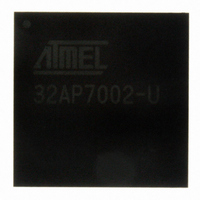AT32AP7002-CTUT Atmel, AT32AP7002-CTUT Datasheet - Page 759

AT32AP7002-CTUT
Manufacturer Part Number
AT32AP7002-CTUT
Description
IC MCU 32BIT AVR32 196-CBGA
Manufacturer
Atmel
Series
AVR®32 AP7r
Specifications of AT32AP7002-CTUT
Core Processor
AVR
Core Size
32-Bit
Speed
150MHz
Connectivity
EBI/EMI, I²C, MMC, PS2, SPI, SSC, UART/USART, USB
Peripherals
AC'97, DMA, I²C, LCD, POR, PWM, WDT
Number Of I /o
85
Program Memory Type
ROMless
Ram Size
32K x 8
Voltage - Supply (vcc/vdd)
1.65 V ~ 1.95 V
Data Converters
D/A 2x16b
Oscillator Type
Internal
Operating Temperature
-40°C ~ 85°C
Package / Case
196-CBGA
Data Bus Width
32 bit
Data Ram Size
32 KB
Interface Type
I2C, JTAG, PS2, SPI, SSC, UART, USART, USB
Maximum Clock Frequency
150 MHz
Number Of Timers
3
Maximum Operating Temperature
+ 85 C
Mounting Style
SMD/SMT
Minimum Operating Temperature
- 40 C
On-chip Dac
16 bit, 2 Channel
Package
196CTBGA
Device Core
AVR32
Family Name
AT32
Maximum Speed
150 MHz
Operating Supply Voltage
1.8|3.3 V
For Use With
ATAVRONEKIT - KIT AVR/AVR32 DEBUGGER/PROGRMMRATNGW100 - KIT AVR32 NETWORK GATEWAYATSTK1000 - KIT STARTER FOR AVR32AP7000
Lead Free Status / RoHS Status
Lead free / RoHS Compliant
Eeprom Size
-
Program Memory Size
-
Lead Free Status / Rohs Status
Details
Available stocks
Company
Part Number
Manufacturer
Quantity
Price
- Current page: 759 of 896
- Download datasheet (13Mb)
34.7
34.8
32054F–AVR32–09/09
Interrupts
Configuration Sequence
The LCD Controller generates six different IRQs. All the IRQs are synchronized with the internal
LCDC Core Clock. The IRQs are:
Each IRQ can be individually enabled, disabled or cleared, in the IER (Interrupt Enable Regis-
ter), IDR (Interrupt Disable Register) and ICR (Interrupt Clear Register) registers. The IMR
register contains the mask value for each IRQ source and the LDC_ISR contains the status of
each IRQ source. A more detailed description of these registers can be found in
(LCDC) User Interface” on page
The DMA Controller starts to transfer image data when the LCDC Core is activated (Write to
PWR field of PWRCON register). Thus, the user should configure the LCDC Core and configure
and enable the DMA Controller prior to activation of the LCD Controller. In addition, the image
data to be shows should be available when the LCDC Core is activated, regardless of the value
programmed in the GUARD_TIME field of the PWRCON register.
To disable the LCD Controller, the user should disable the LCDC Core and then disable the
DMA Controller. The user should not enable the LCDC again until the LCDC Core is in IDLE
state. This is checked by reading the BUSY bit in the PWRCON register.
The initialization sequence that the user should follow to make the LCDC work is:
•DMA Memory error IRQ. Generated when the DMA receives an error response from an HSB
•FIFO underflow IRQ. Generated when the Serializer tries to read a word from the FIFO when
•FIFO overwrite IRQ. Generated when the DMA Controller tries to write a word in the FIFO
•DMA end of frame IRQ. Generated when the DMA controller updates the Frame Base
•End of Line IRQ. This IRQ is generated when the LINEBLANK period of each line is reached
•End of Last Line IRQ. This IRQ is generated when the LINEBLANK period of the last line of
•Create or copy the first image to show in the display buffer memory.
•If a palletized mode is used, create and store a palette in the internal LCD Palette
•Configure the LCD Controller Core without enabling it:
slave while it is doing a data transfer.
the FIFO is empty.
while the FIFO is full.
Address pointers. This IRQ can be used to implement a double-buffer technique. For more
information, see
and the DMA Controller is in inactive state.
the current frame is reached and the DMA Controller is in inactive state.
memory(See Section “34.6.2.5” on page 743.
– LCDCON1 register: Program the CLKVAL and BYPASS fields: these fields control the
pixel clock divisor that is used to generate the pixel clock PCLK. The value to program
depends on the LCDC Core Clock and on the type and size of the LCD Module used.
There is a minimum value of the PCLK clock period that depends on the LCD
Controller Configuration, this minimum value can be found in
748. The equations that are used to calculate the value of the pixel clock divisor can
be found at the end of the section
”Double-buffer Technique” on page
767.
”Timegen” on page 747
761.
Table 34-11 on page
AT32AP7002
”LCD Controller
759
Related parts for AT32AP7002-CTUT
Image
Part Number
Description
Manufacturer
Datasheet
Request
R

Part Number:
Description:
DEV KIT FOR AVR/AVR32
Manufacturer:
Atmel
Datasheet:

Part Number:
Description:
INTERVAL AND WIPE/WASH WIPER CONTROL IC WITH DELAY
Manufacturer:
ATMEL Corporation
Datasheet:

Part Number:
Description:
Low-Voltage Voice-Switched IC for Hands-Free Operation
Manufacturer:
ATMEL Corporation
Datasheet:

Part Number:
Description:
MONOLITHIC INTEGRATED FEATUREPHONE CIRCUIT
Manufacturer:
ATMEL Corporation
Datasheet:

Part Number:
Description:
AM-FM Receiver IC U4255BM-M
Manufacturer:
ATMEL Corporation
Datasheet:

Part Number:
Description:
Monolithic Integrated Feature Phone Circuit
Manufacturer:
ATMEL Corporation
Datasheet:

Part Number:
Description:
Multistandard Video-IF and Quasi Parallel Sound Processing
Manufacturer:
ATMEL Corporation
Datasheet:

Part Number:
Description:
High-performance EE PLD
Manufacturer:
ATMEL Corporation
Datasheet:

Part Number:
Description:
8-bit Flash Microcontroller
Manufacturer:
ATMEL Corporation
Datasheet:

Part Number:
Description:
2-Wire Serial EEPROM
Manufacturer:
ATMEL Corporation
Datasheet:











